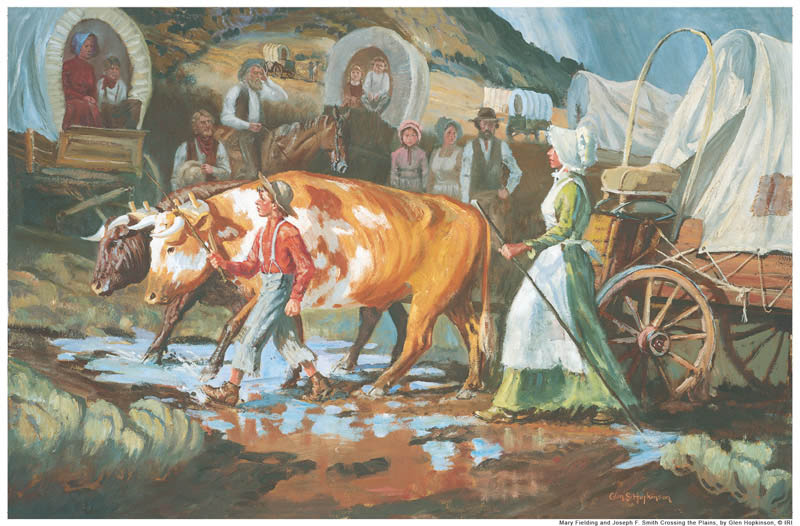This is the first in a series of posts about teenagers who were Mormon pioneers.
 July 24 is Pioneer Day. For Mormon teenagers, this is a day of fireworks and parades, but it’s also a day to remember the Mormon pioneers. Can you imagine spending your teen years walking across the country, helping to pull a handcart because you can’t afford a covered wagon, maybe watching your friends, siblings, or even your parents die along the way? That’s how it was for a lot of teenagers. There were dances, but they were held after a really long day of walking. They had friends, but they talked as they worked or walked. These teens had to be adults long before a modern teenager might have to, just because they had so much responsibility and they’d already had hard lives. Many had lost parents or watched their homes destroyed. Some had even been attacked and every day they faced serious dangers from people who had forgotten our country believes in religious freedom. That kind of life makes you grow up fast.
July 24 is Pioneer Day. For Mormon teenagers, this is a day of fireworks and parades, but it’s also a day to remember the Mormon pioneers. Can you imagine spending your teen years walking across the country, helping to pull a handcart because you can’t afford a covered wagon, maybe watching your friends, siblings, or even your parents die along the way? That’s how it was for a lot of teenagers. There were dances, but they were held after a really long day of walking. They had friends, but they talked as they worked or walked. These teens had to be adults long before a modern teenager might have to, just because they had so much responsibility and they’d already had hard lives. Many had lost parents or watched their homes destroyed. Some had even been attacked and every day they faced serious dangers from people who had forgotten our country believes in religious freedom. That kind of life makes you grow up fast.
The teenagers in the early church had interesting lives and many of them recorded their experiences in journals or later wrote their life stories. One boy, Henry Sanderson, became a Mormon when he was thirteen. He lived in Connecticut and when his parents converted, he had to endure a lot of teasing and bullying from people who didn’t like Mormons. He was relieved when his parents decided to move to Nauvoo to live with the Mormons, so he could escape the persecution. There, he became friends with the sons of Joseph Smith, the Mormon prophet, who lived two houses from him. Every tenth day, Henry helped to build the church’s temple, a special building used for sacred ordinances.
Joseph Smith was murdered when Henry was fifteen. He had watched as Joseph was arrested and taken to prison on false charges, which allowed him to be killed without protection from his own people. For a while, people weren’t sure what would happen to the church. The murderers hoped the church would die with Joseph, but it didn’t. Brigham Young took over and life went on, but not exactly as before. Things became very hard for the Saints, as the Mormons called themselves, and Henry’s family needed income. He and his father went to St. Louis to find work and Henry was hired to work for shoemakers. At fifteen, he worked full-time.
In 1845, the family moved to a farm, where his father was hired to work. However, an illness, probably malaria, struck and Henry’s father died. In those days, that meant the oldest son, Henry, was now responsible for making sure the family survived. However, Henry himself was also ill with the same disease. Despite this, the family returned to Nauvoo, the city where the Mormons lived. One sister stayed behind to work for a bit, so Henry, still sick, returned to bring her back when her job ended. He worked for his passage as an assistant fireman one way and a cook and dishwasher the other way.
At age seventeen, Henry joined the Nauvoo Legion. The Saints were in a lot of danger. Joseph Smith’s murder hadn’t ended their persecution and the Saints knew they could all be killed at any time. He had a gun and helped patrol the city, watching for enemy mobs.
When the Saints finally decided they were going to have to leave Nauvoo, Henry and his family joined them on the trek west. Henry worked for another family to help pay the costs. However, the United States government stopped the travelers and asked for volunteer soldiers to help fight the Mexican War. Henry was sure Brigham Young would refuse, because the government had refused to protect the Saints in their time of danger. To his surprise, Brigham Young agreed and Henry became a soldier. When his time ended, he entered the Salt Lake Valley, but he wanted to be with his family, so he traveled with Brigham Young’s company to Winter Quarters, where many of the pioneers were preparing for the journey. He returned to Utah in three years.
Henry’s life was unusual compared to teens today. By the time he was an adult, he had lost his father, been a soldier, led a family, worked full-time, and become a pioneer. His teen years weren’t filled with the fun of a typical teenager, but he never complained about it. He was proud of what he had accomplished at such a young age.
This story is retold from William G. Hartley, “Nauvoo Teenager: Henry Sanderson,” New Era, Oct 1989, 44. Read the story to learn more about his teenage years.
